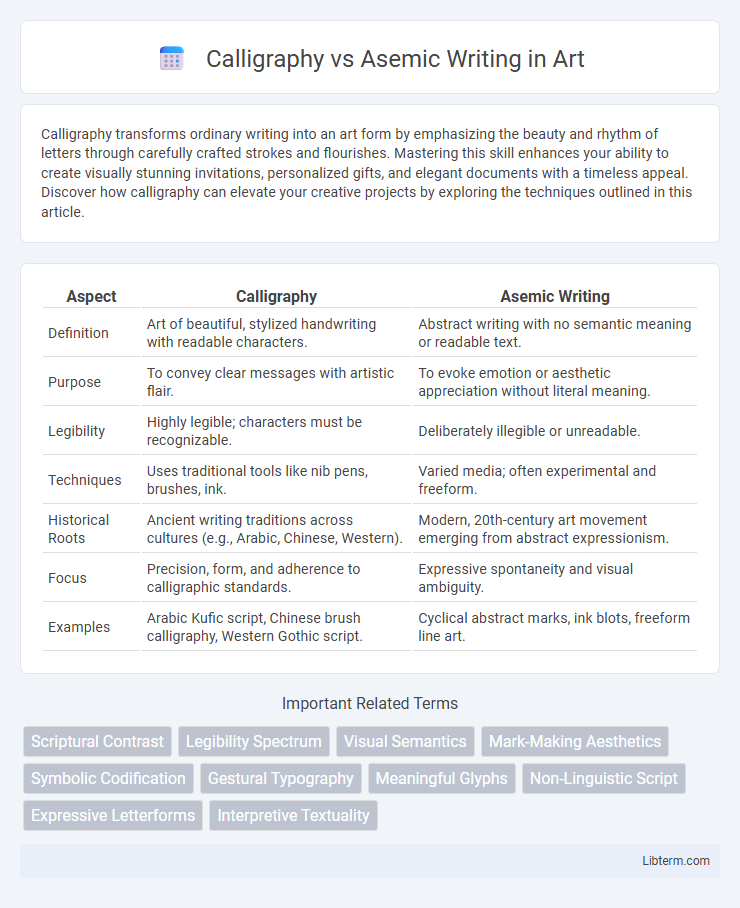Calligraphy transforms ordinary writing into an art form by emphasizing the beauty and rhythm of letters through carefully crafted strokes and flourishes. Mastering this skill enhances your ability to create visually stunning invitations, personalized gifts, and elegant documents with a timeless appeal. Discover how calligraphy can elevate your creative projects by exploring the techniques outlined in this article.
Table of Comparison
| Aspect | Calligraphy | Asemic Writing |
|---|---|---|
| Definition | Art of beautiful, stylized handwriting with readable characters. | Abstract writing with no semantic meaning or readable text. |
| Purpose | To convey clear messages with artistic flair. | To evoke emotion or aesthetic appreciation without literal meaning. |
| Legibility | Highly legible; characters must be recognizable. | Deliberately illegible or unreadable. |
| Techniques | Uses traditional tools like nib pens, brushes, ink. | Varied media; often experimental and freeform. |
| Historical Roots | Ancient writing traditions across cultures (e.g., Arabic, Chinese, Western). | Modern, 20th-century art movement emerging from abstract expressionism. |
| Focus | Precision, form, and adherence to calligraphic standards. | Expressive spontaneity and visual ambiguity. |
| Examples | Arabic Kufic script, Chinese brush calligraphy, Western Gothic script. | Cyclical abstract marks, ink blots, freeform line art. |
Introduction to Calligraphy and Asemic Writing
Calligraphy is the art of beautiful, stylized handwriting that follows specific scripts and techniques, emphasizing form, structure, and legibility. Asemic writing, by contrast, is a form of abstract, wordless writing that lacks semantic content and traditional linguistic rules, often resembling calligraphy but prioritizing expressive freedom. Both practices explore visual language; calligraphy conveys meaning through letterforms, while asemic writing highlights the artistic form without explicit textual interpretation.
Defining Calligraphy: Art of Beautiful Writing
Calligraphy is the art of beautiful writing that emphasizes elegant, stylized letterforms crafted with precision and skill. It combines traditional techniques with specialized tools like nib pens and brushes to create visually harmonious text, often reflecting cultural and historical influences. Unlike asemic writing, calligraphy conveys meaning through legible and aesthetically enhanced script.
What is Asemic Writing?
Asemic writing is a form of abstract, wordless writing that lacks specific semantic content but retains the visual qualities of traditional script. Unlike calligraphy, which emphasizes legibility and decorative letterforms, asemic writing prioritizes expressive, freeform marks that evoke the appearance of language without conveying a readable message. This art form blurs the boundaries between writing and drawing, inviting varied interpretation through its ambiguous, symbolic strokes.
Historical Origins and Evolution
Calligraphy originates from ancient civilizations such as China and Egypt, where structured, ornamental writing systems developed to communicate and record cultural heritage. Asemic writing, emerging in the 20th century, evolved as an abstract, wordless form that challenges traditional literacy by emphasizing expressive, visual creativity rather than semantic content. Both art forms reflect evolving human interaction with text, with calligraphy rooted in formal script traditions and asemic writing representing a departure toward free-form, interpretive marks.
Key Differences Between Calligraphy and Asemic Writing
Calligraphy involves the artful, deliberate formation of stylized letters with clear linguistic meaning, often using specialized tools like brushes or pens to enhance visual elegance. Asemic writing, by contrast, is a form of abstract writing that lacks semantic content and recognizable words, emphasizing expressive marks and shapes instead of readable text. The key difference lies in calligraphy's focus on legibility and traditional scripts, while asemic writing prioritizes visual aesthetics without conveying specific language or meaning.
Tools and Techniques Compared
Calligraphy employs specialized tools such as nib pens, brushes, and ink to create precise, stylized letterforms with controlled strokes that emphasize legibility and aesthetic harmony. Asemic writing, in contrast, utilizes a broader range of unconventional tools like markers, charcoal, or digital styluses to produce abstract, non-literal marks without semantic constraints, focusing on spontaneous expression rather than structured letterforms. The techniques in calligraphy demand rigorous practice to master consistent rhythm and stroke order, while asemic writing encourages freeform gestures and intuitive movements that prioritize artistic freedom over formal rules.
Artistic Purposes and Intentions
Calligraphy emphasizes precise, stylized letterforms to convey meaning through legible text, often used for decorative or ceremonial purposes. Asemic writing, lacking semantic content, focuses on abstract, expressive marks that invite open interpretation and evoke emotion without relying on conventional language. Both practices serve artistic intentions by exploring the visual form of writing, but calligraphy anchors itself in communication while asemic writing prioritizes aesthetic experience.
Cultural Significance and Global Impact
Calligraphy holds profound cultural significance across civilizations, symbolizing artistic heritage and linguistic identity with its precision and stylistic rules. Asemic writing, devoid of semantic content, transcends language barriers by emphasizing emotional expression and visual aesthetics, fostering cross-cultural dialogue in contemporary art. Both forms influence global art movements, with calligraphy preserving tradition and asemic writing pushing boundaries of meaning and communication.
Modern Applications in Art and Design
Calligraphy emphasizes structured, elegant letterforms often used in branding, logo design, and digital typography to convey clarity and sophistication. Asemic writing creates abstract, wordless marks that evoke emotional or conceptual narratives in contemporary art installations and graphic design. Modern artists and designers integrate both to explore the balance between legibility and expression, enhancing visual storytelling and aesthetic innovation.
Choosing Between Calligraphy and Asemic Writing
Choosing between calligraphy and asemic writing depends on your goal: calligraphy emphasizes precise, legible letterforms rooted in tradition and technique, ideal for formal documents and artistic lettering. Asemic writing offers abstract, wordless marks focusing on visual expression and emotional impact without semantic constraints. Selecting calligraphy suits structured communication, whereas asemic writing favors freeform creativity and interpretive engagement.
Calligraphy Infographic

 libterm.com
libterm.com